Posted: April 29th, 2017 | No Comments »
An interesting new book by Patricia O’Sullivan in the Royal Asiatic Society’s Hong Kong Studies list of occasional titles (published now by Blacksmith Books)….
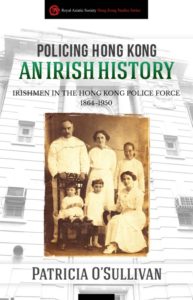
Hong Kong, 1918. A tranquil place compared to war-torn Europe. But on the morning of the 22nd January, a running battle through the streets of Wanchai ended in “The Siege of Gresson Streetâ€. Five policemen lay dead, so shocking Hong Kong that over half the population turned out to watch their funeral procession.
One of the dead, Inspector Mortimor O’Sullivan, came from Newmarket: a small town nestled deep in rural Ireland. He, along with a dozen and more relatives, had sailed out to Hong Kong to join the Police Force.
Using family records and memories alongside extensive research in Hong Kong, Ireland and London, Patricia O’Sullivan tells the story of these policemen and the criminals they dealt with. This book also gives a rare glimpse into the day-to-day life of working-class Europeans at the time, as it follows the Newmarket men, their wives and families, from their first arrival in 1864 through to 1941 and beyond.
“This groundbreaking book is a story of life, death, and crime in colonial Hong Kong. It is also an account of an important part of Hong Kong’s population that has eluded most historians: the European working class. With an arsenal of previously untapped materials in Ireland, Britain and Hong Kong, Patricia O’Sullivan tells the remarkable tales of the families who built their own ‘little Ireland’ in Hong Kong.†– John M. Carroll, Dept. of History, University of Hong Kong
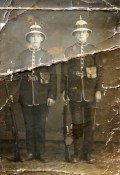
Posted: April 28th, 2017 | No Comments »
China Rhyming readers may be interested in the third ‘Crime in the City’ feature I’ve published at Lit Hub – it’s on Manila – here
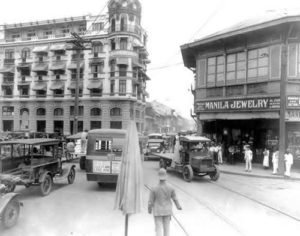
Posted: April 27th, 2017 | No Comments »
In the mid-1950s, shortly after the communists took power, it seems Picasso’s Dove of Peace became a brief leitmotif around Shanghai. Here’s a picture of Nanking Road in the early 1950s, close by the Park Hotel and the pailou (a version of which still remains) on the north side of the road opposite the old racecourse.
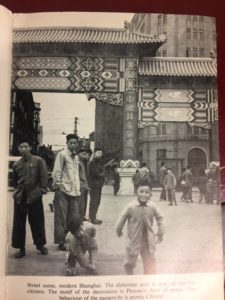
And here you can see the Dove of Peace painted on a cargo ship moored at a Shanghai wharf.
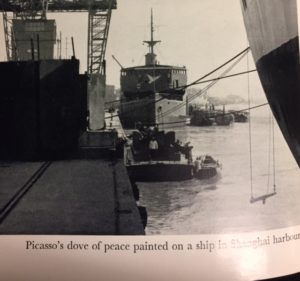
Memoirs and visitors records in the mid-1950s often recall Picasso’s Doe of Peace appearing on stamps, postcards, the covers of magazines and newspapers and even featuring in a popular propaganda song, “Grandma Wants Peace”. Not just in Shanghai but across China.
Actually the regularity of Picasso’s Doves appearance is interesting as it shows the closeness between the USSR and Communist China prior to the Sino-Soviet Split. The Dove was really the symbol of the Moscow-led “peace initiative” aimed against the American and UN presence in Korea. Obviously both China and the USSR were supporting Kim Il-sung’s forces in the North.
Anything with the Dove of Peace does rather handily allow us to date images as being the mid-1950s…

Chinese Dove of Peace stamps
Posted: April 26th, 2017 | No Comments »
According to the Ogden Standard Examiner in 1929…

not much changed there then….
Posted: April 25th, 2017 | No Comments »
Chloe Lai at The Hong Kong Free Press has written an obituary for Hong Kong’s Central Market… it says pretty much all that needs to be said about the Central Market – that it is one of the only pre-war pieces of architecture designed for the community to remain standing – Wan Chai Market went over a decade ago now. It’s being described as a preservation, but is a complete gutting and destruction. Chloe Lai’s piece has more details and I urge you to read that.
The Central Market was never Hong KOng’s most beautiful building – but it was a functional, well designed space completed in 1939 that showed that the government’s Public Works Department could excel itself. It’s destruction later this year will be a sad loss for Hong Kong…


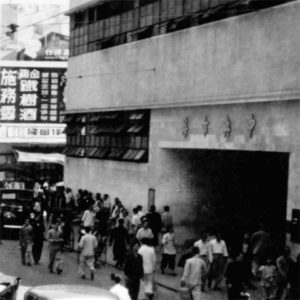

Posted: April 24th, 2017 | No Comments »
In a rush today, but couldn’t resist posting this – the bizarre Chinese carved ivory ‘ladies companion’….surely an objet every collection of China curios should include….
more here
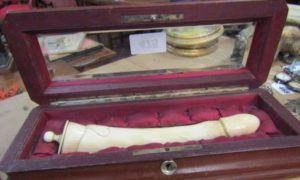
Posted: April 21st, 2017 | No Comments »
ALR33 pays tribute to the under-appreciated heroes of world literature – the Translators. This issue features some of the entries and finalists from our collaboration with English PEN on awarding outstanding translations from East and Southeast Asia. For a sampling, read our selection of free-to-view articles, including From the Editors and Shion Miura’s The Handymen of Mahoro, translated by Asuka Minamoto. Also, sample some of the issue’s poetry with Tishani Doshi and Norman Erikson Pasaribu, and enjoy our interview with Margrét Helgadóttir, editor of Asian Monsters, from which we include two stories. Subscribers can read the whole issue online or by downloading eBooks from their accounts.
If you’re already a subscriber, click here to sign in, download your eBook copy and start reading.
If you’re not yet a subscriber, please visit our website to find out more.

Posted: April 20th, 2017 | No Comments »
Beijing proves, once again, that it has no interest whatsoever in heritage, preservation or architecture as it decides to bulldoze the 1910 built Qinghuayuan Railway Station (details from The Beijinger here). Words cannot describe how horrible this is – though I do hope that those who email me telling me that heritage is now a priority in China and the destruction has stopped in Beijing (and Shanghai and elsewhere) will realise their errors.
Anyway, as we shed a tear in farewell to Qinghuayuan, which managed to survive 107 years, here’s Frank G. Carpenter, the American travellers, author, photographer and journalist, in 1910 passing along the line between Peking and Kalgan (or Zhangjiakou if you must) when he decided to travel on all of China’s new railways….you can click on it to enlarge….














